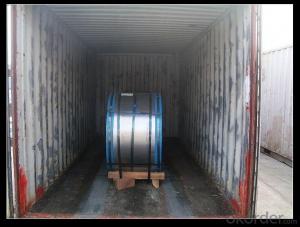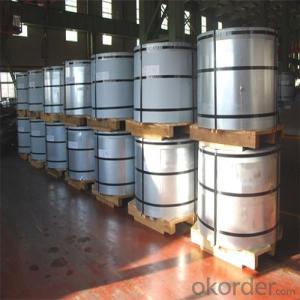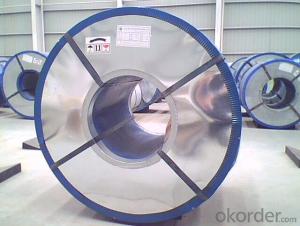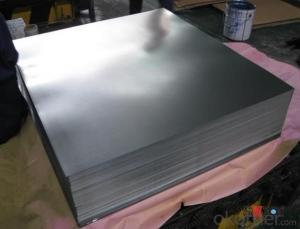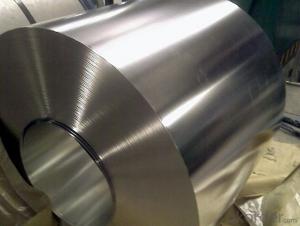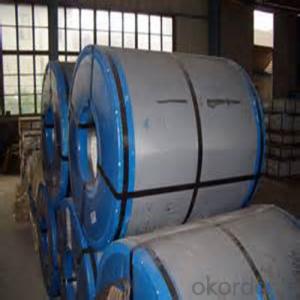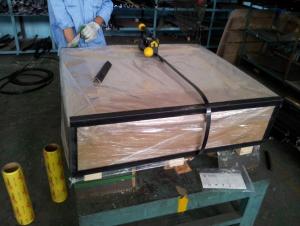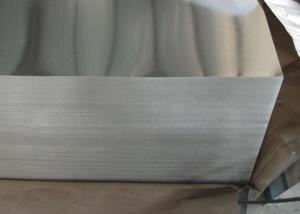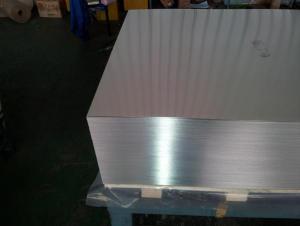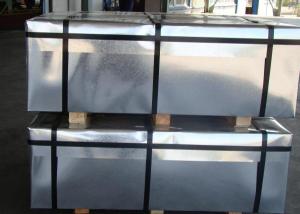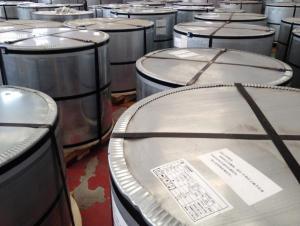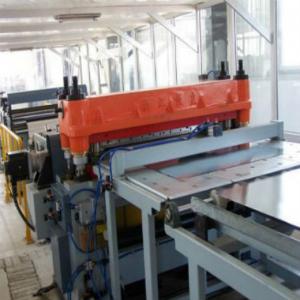Electrolytic Tinplate in Coils for Foods Tin Packing
- Loading Port:
- Tianjin
- Payment Terms:
- TT OR LC
- Min Order Qty:
- 25 m.t
- Supply Capability:
- 7000 m.t/month
OKorder Service Pledge
OKorder Financial Service
You Might Also Like
1.Structure of Electrolytic Tinplate in Coils for Foods Tin Packing Description
Electrolytic Tin Plate Coils and Sheets for Foods Metal Packaging, is one thin steel sheet with a coating of tin applied by electrolytic deposition. Tinplate made by this process is essentially a sandwich in which the central core is strip steel. This core is cleaned in a pickling solution and then fed through tanks containing electrolyte, where tin is deposited on both sides. As the strip passes between high-frequency electric induction coils, it is heated so that the tin coating melts and flows to form a lustrous coat.
2.Main Features of the Electrolytic Tinplate in Coils for Foods Tin Packing
Appearance – Electrolytic Tin Plate is characterized by its beautiful metallic luster. Products with various kinds of surface roughness are produced by selecting the surface finish of the substrate steel sheet.
Paintability and printability – Electrolytic Tin Plates have excellent paintability and printability. Printing is beautifully finished using various lacquers and inks.
Formability and strength – Electrolytic Tin Plates have got very good formability and strength. By selecting a proper temper grade, appropriate formability is obtained for different applications as well as the required strength after forming.
Corrosion resistance – Tinplate has got good corrosion resistance. By selecting a proper coating weight, appropriate corrosion resistance is obtained against container contents. Coated items should meet 24 hour 5 % salt spray requirement.
Solderability and weldability – Electrolytic Tin Plates can be joined both by soldering or welding. These properties of tinplate are used for making various types of cans.
Hygienic – Tin coating provides good and non toxic barrier properties to protect food products from impurities, bacteria, moisture, light and odours.
Safe – Tinplate being low weight and high strength makes food cans easy to ship and transport.
Eco friendly – Tinplate offers 100 % recyclability.
Tin is not good for low temperature applications since it changes structure and loses adhesion when exposed to temperatures below – 40 deg C.
3.Electrolytic Tinplate in Coils for Foods Tin Packing Images
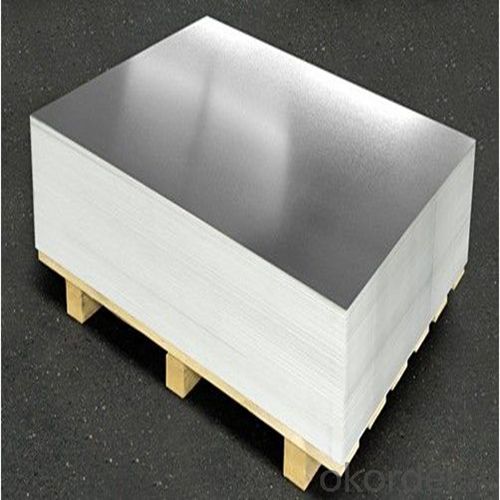
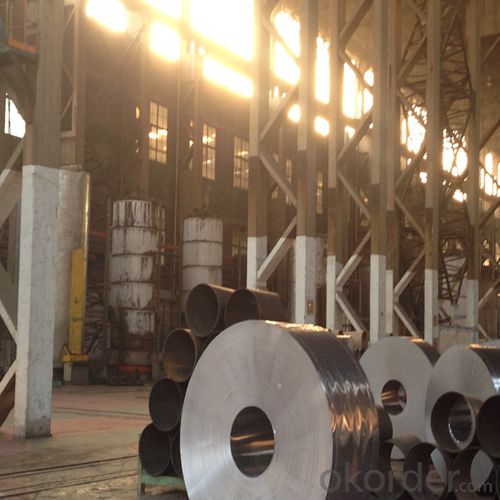

4.Electrolytic Tinplate in Coils for Foods Tin Packing Specification
Standard | ISO 11949 -1995, GB/T2520-2000,JIS G3303,ASTM A623, BS EN 10202
|
Material | MR,SPCC |
Thickness | 0.15mm - 0.50mm |
Width | 600mm -1150mm |
Temper | T1-T5 |
Annealing | BA & CA |
Coil Inner Diameter | 508mm |
Weight | 6-10 tons/coil 1~1.7 tons/sheets bundle |
Passivation | 311 |
Oil | DOS |
Surface | Finish,bright,stone,matte,silver |
5.FAQ of Electrolytic Tinplate in Coils for Foods Tin Packing
- How are the Electrolytic Tin Plates specified?
The Electrolytic Tin Plates are specified as per the steel base, extent of tempering, the coating weight, annealing method and the surface finish.
- How many types there are for base steels?
The base steels are of three types: Type MR, L, D
- Q: How does tinplate affect the overall product freshness?
- Tinplate plays a significant role in preserving the overall product freshness. Its unique properties, such as excellent barrier properties against light, oxygen, and moisture, help in extending the shelf life of the contents inside the tinplate packaging. This prevents oxidation, spoilage, and contamination, ensuring that the product remains fresh and retains its quality for a longer period of time.
- Q: What are the main applications of tinplate?
- The main applications of tinplate include food and beverage packaging, aerosol cans, electrical components, and decorative items.
- Q: And what are the main packing materials?
- The difference between the two cans is usually called a tin plate of three cans. The material is usually made of tin and hence its name. Canned container used for beverage, dry powder, chemical product, aerosol product.
- Q: How does tinplate withstand corrosion?
- Tinplate withstands corrosion due to the presence of a thin layer of tin coating on its surface. This tin layer acts as a barrier, preventing direct contact between the tinplate and the surrounding environment, thus protecting it from rust and corrosion.
- Q: What are the hygiene benefits of tinplate packaging?
- Tinplate packaging offers several hygiene benefits, including providing a protective barrier against external contaminants, preventing cross-contamination, and preserving the quality and freshness of the packaged products. Additionally, tinplate packaging is resistant to corrosion, ensuring the integrity of the packaging and its contents.
- Q: What are the advantages of tin packaging?
- Mature technology and high production efficiency: the production of tinplate has a long history, has a mature skill set of production equipment with matching, high production efficiency, can meet a variety of product packaging needs.
- Q: How does tinplate contribute to the attractiveness of cosmetic packaging?
- Tinplate contributes to the attractiveness of cosmetic packaging due to its unique properties. Its shiny and reflective surface enhances the visual appeal of the packaging, making it look more luxurious and high-end. Additionally, tinplate offers excellent printability, allowing for intricate designs, vibrant colors, and high-quality graphics to be displayed on the packaging, which further enhances its attractiveness. The durability and strength of tinplate also ensure that the packaging remains intact and visually appealing throughout its lifespan.
- Q: What are the advantages of using tinplate for automotive components?
- There are several advantages of using tinplate for automotive components. Firstly, tinplate is highly corrosion resistant, which helps protect the components from rust and prolongs their lifespan. Additionally, tinplate provides excellent formability, allowing for complex shapes and designs to be easily manufactured. It also offers good strength and durability, ensuring the components can withstand harsh conditions and maintain their structural integrity. Furthermore, tinplate has good heat resistance properties, making it suitable for components that are exposed to high temperatures. Lastly, tinplate is a sustainable material as it is recyclable, contributing to environmental sustainability in the automotive industry.
- Q: What are the different methods of disposing of tinplate packaging?
- The different methods of disposing of tinplate packaging include recycling, reusing, and proper disposal in designated waste receptacles. Recycling involves separating the tinplate packaging from other waste and placing it in recycling bins or taking it to recycling centers. Reusing tinplate packaging involves finding alternative uses for it, such as storage containers or decorative items. If recycling or reusing is not possible, tinplate packaging should be disposed of in designated waste disposals to prevent environmental harm.
- Q: Can tinplate packaging be used for gift items?
- Yes, tinplate packaging can be used for gift items. Tinplate is a durable and visually appealing material that can be used to create unique and attractive packaging for various gift items. It offers excellent protection for the contents and can be customized with different designs and finishes to enhance the overall presentation of the gift.
Send your message to us
Electrolytic Tinplate in Coils for Foods Tin Packing
- Loading Port:
- Tianjin
- Payment Terms:
- TT OR LC
- Min Order Qty:
- 25 m.t
- Supply Capability:
- 7000 m.t/month
OKorder Service Pledge
OKorder Financial Service
Similar products
Hot products
Hot Searches
Related keywords


